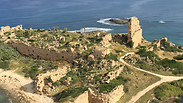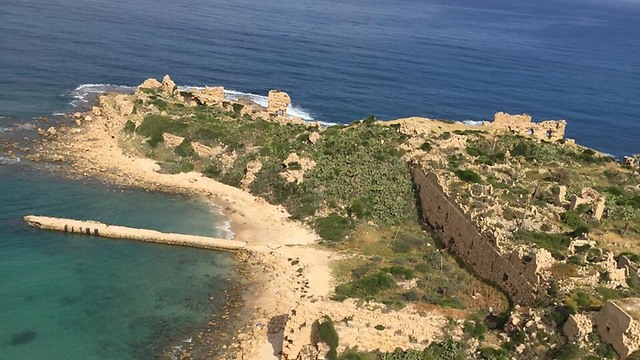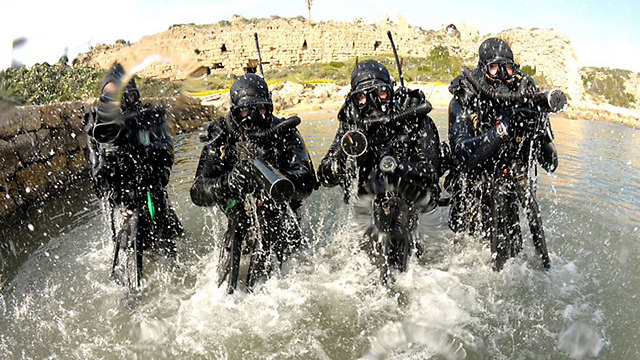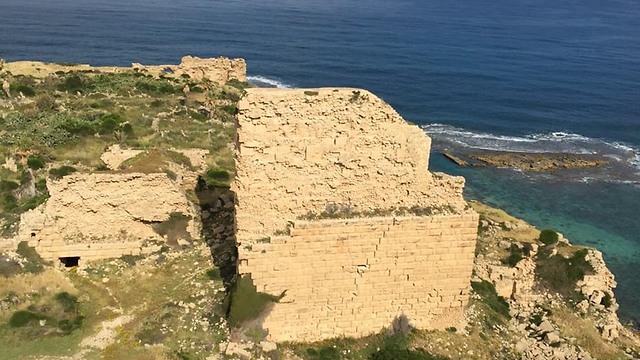
The fight over Château Pèlerin—the ancient Crusader fortress
The ancient castle, currently under the control of the navy’s commando unit, is again in the midst of controversy; the IDF wants to keep it as part of the naval commando’s base of operations, yet residents of the area want it to be opened for tourism, which will generate significant income; researchers are keeping silent, hoping to keep the site intact.
People are once again attempting to open the Crusader fortress Château Pèlerin for public access, taking it out of IDF control.
The castle, also called Atlit fortress and Castle Pilgrim, is an 800-year-old fortress hailed by many as one of the most beautiful archeological sites in Israel. It is located near Atlit on the northern coast of Israel and is currently in a closed military zone which serves as a training area for IDF Naval commandos.
As such, civilian access to it is forbidden.
Now, a decade after protests failed to open the site for public access and tourism, the struggle over its control has resumed.
The castle was under the control of the Knights Templar during the 13th century and was never placed under siege due to its excellent strategic location.
In the 1950’s, the fortress was seized by the IDF’s navy, which made it into a secret base for its commando unit—Shayetet 13.
Jacob (Koby) Sharvit, director of the Marine Archaeology Unit in Israel’s Antiquities Authority, explained that “the place’s beauty stems from its island-like location. It is a very fortified castle, bigger than anything like it in Israel: its outer and inner walls are all still there, as well as its fortified gates.
“When you visit the site you can even see the halls and facilities used by the Knights Templar, like baking ovens and remnants of the church."
Dan Hamizer, a resident of the area and an activist in the Blue & Green Association, which now fights to return the military controlled zones in Atlit to the public, said that “The city’s beach and the fortress were officially closed in 1970 under a military decree. What is that? It’s military occupation.”
Hof HaCarmel Regional Council Mayor Carmel Sela estimated that opening the site for international tourism will generate an income of millions of shekels. He also noted the site's historical significance by saying, “The fortress will turn 800 this year... the site was the most important fortress in the Middle East. It housed the entirety of the Crusaders' upper ranks, including their commander, and even contained their bank. It is an extraordinary tourist attraction that we, the public, cannot enjoy.”
A combatant who serves in the navy commando reserves took pride in the fortress which has become a symbol of the commando, reciting his unit’s mantra: “only those who passed our training and got the combatant’s badge can feast their eyes on the fortress.”
At the residents' pleas, the former combatant showed sympathy and expressed understanding, saying “there was a time when we used to gather our unit’s special armaments in the Atlit bay and it was justifiably a secret.” But, “nowadays, anyone can pilot a drone from the nearby town to just look at whatever he wants at the base. From a military perspective, I don’t think it will be any problem to move the Shayetet’s base of operations to the Eilat harbor."
He then ended by saying that “the Atlit beach has a magnificent sea with Zionist history from the time of the British Mandate and it’s unfortunate that anyone who doesn’t have family serving in the navy would never get to see the place.”
Archeologists, though, have seen much improvement in the army’s treatment of the site, which may be the reason why the Antiquities Authority are no longer taking part in the fight for control over the site.
In the past, the military used to hold ceremonies at the site, involving crowds and pyrotechnics, and even used the fortresses’ walls as target practice, but it stopped altogether and now grants researches and scientists permission to work and excavate there, maintaining field security protocol.
Some claim the site is better off that way, noting that without visitors it can be well kept.
Under the sea, deep underneath the bay, hides one of the most interesting diving sites in Israel. In the last few years, the remains of an ancient fishing village from the Neolithic period were found well preserved about 10 meters below the surface. It included huts, graves, a well, fire pits and even a mysterious ritual site.
A few years ago, French researchers excavated several graves in the crusader cemetery near the fortress, and by studying DNA samples from the remains found a connection between the buried knights and their decedents now living in France.
In the meantime, Hamizer is left with only the memories of the time when he visited the fortress as a child. “It was a really special place to visit, it has been years and I would love to visit it again,” he said, summarizing that “at the end of the day, the people at the Ministry of Defense are like the biggest real estate agents in the country. Even if the navy relinquishes control of the site, they can say ‘no way, this is our turf,’ and keep it.”
The IDF responded that “the naval commando base in Atlit was founded and maintained according to procedures and hosts a wide range of defense activities every day of the week.
“Its position and overall area are the result of the unique operational necessities of the units active in it, which requires the navy’s continued operations in its current facilities.
“We also note that entry of state-authorized researchers is now being allowed in a procedure arranged with the navy, the Defense Ministry and several other authorities. Currently, work is being done in cooperation with the Antiquities Authority to prepare the fortress towards its planned opening to the public, which will happen several times a year.”
(Translated & edited by Lior Mor)














